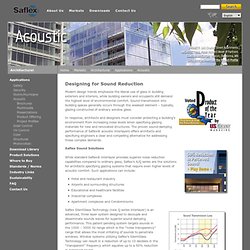

Effective high quality sound absorbers - buy now here. Room Acoustic Comfort. TMsoundproofing.com - Soundproofing Materials and Articles. STC/IIC Sound Test Data, Concrete Structural Deck. Advanced Acoustic Glazing Technology for Architectural Applications. Modern design trends emphasize the liberal use of glass in building exteriors and interiors, while building owners and occupants still demand the highest level of environmental comfort.

Sound transmission into building spaces generally occurs through the weakest element – typically, glazing constructed of ordinary window glass. In response, architects and designers must consider protecting a building’s environment from increasing noise levels when specifying glazing materials for new and renovated structures. The proven sound-damping performance of Saflex® acoustic interlayers offers architects and specifying engineers a clear and compelling alternative for addressing these complex demands. Saflex Sound Solutions While standard Saflex® interlayer provides superior noise reduction capabilities compared to ordinary glass, Saflex’s A/Q series are the solutions for architects specifying glazing systems that require even higher levels of acoustic comfort. Other Benefits of Laminated Glass. Sound Control Doors QuietSlide™ Series. Stegbar - Acoustics. Noise reduction refers to the amount of sound which is removed as it passes through a closed window or a wall.

However no matter how good the window is at keeping noise out, if it is not installed and sealed properly during construction, noise will still penetrate the home – all air gaps must be sealed off to ensure that a window will achieve the best noise reduction it can. The Sound Transmission Class (STC) reflects the amount of noise that is reduced when sound passes through the window. So if the noise outside is 70dB and inside it is 40dB, the window is said to have an STC rating of 30. Normally the human ear cannot detect a 1-2dB change in sound. However a 10dB decrease in the sound is subjectively heard by the human ear as a halving of the sound – e.g. a 40dB noise seems half as loud as a 50dB noise. Sound waves are what carry noise into a home. Download the Stegbar Noise PDF data sheet. Architectural Products - AIS Glass Solutions. Www.bobgolds.com/AbsorptionCoefficients.htm. 0.00 = no absorbtion. 0.50 = 50% absorbtion. 1.00 = 100% absorbtion.
Measurements are done according to a standard test method such as ASTM C423 or ISO. "In some cases, the measured sound absorption coefficient is greater than 1.00. As recommended by the test method, these values are reported as measured and not adjusted. " "Differences in coefficients of less than 0.15 are not significant. " "The absorption coefficients that are typically published for acoustical materials are found using the reverberation chamber method. Owens Corning 700 series Rigid Fiberglass Owens Corning I'm unable to find Absorption Coefficient information on SOFTR Aeroflex Plus Acoustical Duct Liner (rolls, black on one side).
Owens Corning Fiberglass Batts (fluffy pink), on the wall, and 16" from the wall Roxul Rigid Rockwool Rockwool.com Note, Roxul may be a Canadian/USA subsiduary of Rockwool. BBC 1992-10.pdf. Johns Manville or here. Absorption coefficients of building materials and finishes RT60 alpha coefficient acoustic absorbing material absorbtion. Acoustic Tables of Reference. Tectum-The Noise Control Solution. Silent Source: Acoustic Foam, Acoustical Soundproofing Materials, Whisperwedge, Materials, Acoustical Panel, Profoam, Tecnifoam, Fireflex, and more.
Architectural. About GIB® » GIB® KriegerSonic Doors: Acoustical Test Report Comparison: Performance Combinations: ASTM E-90 & E-413. Ceilings.